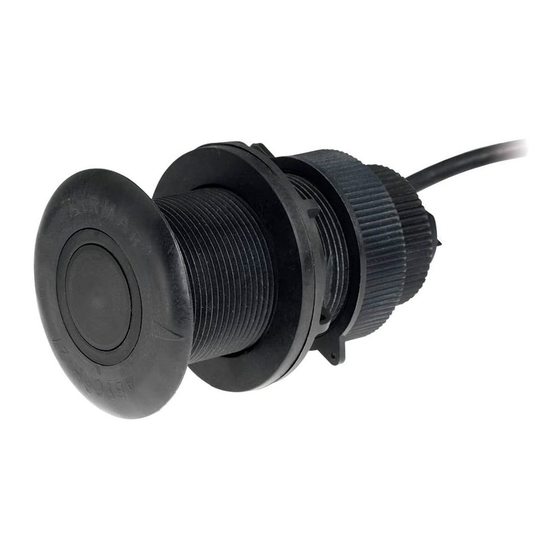
Table of Contents
Advertisement
Quick Links
OWNER'S GUIDE & INSTALLATION INSTRUCTIONS
Thru-Hull
:
Retractable with Valve
Tilted Element
Model DT800
Patent http://www.airmar.com/patent.html
Follow the precautions below for optimal
product performance and to reduce the risk of
property damage, personal injury, and/or death.
WARNING: Always wear safety glasses, a dust mask, and
ear protection when installing.
WARNING: The YELLOW O-ring must be in place near the
top of the insert to make a watertight seal.
WARNING: To retrofit the insert in a housing without a
valve, the insert must have a BLACK O-ring near the top to
make a watertight seal.
WARNING: The O-rings must be intact and well lubricated
to make a watertight seal.
WARNING: The valve is not a watertight seal! Be sure the
insert or blanking plug is fully inserted into the housing, and
the cap nut is screwed on completely.
WARNING: Always attach the safety wire to prevent the
insert or blanking plug from backing out in the unlikely event
that the cap nut fails or is screwed on incorrectly.
WARNING: Immediately check for leaks when the boat is
placed in the water. Do not leave the boat unchecked for
more than three hours. Even a small leak may allow
considerable water to accumulate.
WARNING: Stainless steel housing in a metal hull—Be
sure the washer contacts the hull. Do not tighten the hull nut
with the washer against the isolation bushing, as the
housing will not be firmly installed. If necessary sand the
isolation bushing until the washer rests against the hull.
CAUTION: Plastic housing—Never use a fairing with a
plastic housing; the protruding sensor would be vulnerable
to damage from impact.
CAUTION: Metal housing—Never install a metal housing in
a vessel with a positive ground system.
CAUTION: Never pull, carry, or hold the transducer by its
cable; this may sever internal connections.
CAUTION: The arrow on the top of the transducer must
point toward the keel or centerline of the boat. This will align
the angle of the element inside the transducer with the
deadrise angle of your hull.
CAUTION: Stainless steel housing in a metal hull—The
stainless steel housing must be isolated from a metal hull to
prevent electrolytic corrosion. Use the isolation bushing
supplied.
CAUTION: Never use solvents. Cleaner, fuel, sealant, paint,
and other products may contain solvents that can damage
plastic parts, especially the transducer's face.
IMPORTANT: Read the instructions completely before
proceeding with the installation. These instructions
supersede any other instructions in your instrument manual
if they differ.
Temperature Sensor
&
Transducer
™
Tilt Angles: 0
, 12
, 20
Record the information found on the cable tag for future
reference.
Applications
• Plastic housing recommended for fiberglass or metal hull only.
Never install a plastic housing in a wood hull since swelling of
the wood can fracture the plastic.
• Bronze housing recommended for fiberglass or wood hull.
Never install a bronze housing in an aluminum hull because
electrolytic corrosion will occur.
• Stainless steel housing compatible with all hull materials.
Recommended for aluminum hulls to prevent electrolytic
corrosion provided the stainless steel housing is isolated from
the metal hull.
Match Tilt Angle of Transducer to Deadrise
Be sure your transducer model matches the deadrise angle of
your boat at the mounting location. See the top of the transducer
insert for the tilt angle (Figure 1). To measure the deadrise angle of
your hull at the selected mounting location, use an angle finder or a
digital level (Figure 2).
• 0° model for deadrise angles from 0° to 7°
• 12° model for deadrise angles from 8° to 15°
• 20° model for deadrise angles from 16° to 24°
0° model
Figure 1. Top of transducer insert
Copyright © 2006 Airmar Technology Corp.
transom view
Figure 2. Deadrise angle of the hull
Copyright © 2005 Airmar Technology Corp.
Smart
Plastic
Low profile
P617V housing
12° model
20° model
slope of hull
deadrise angle
parallel to waterline
Sensor
™
Advertisement
Table of Contents

Summary of Contents for Airmar DT800
- Page 1 CAUTION: Stainless steel housing in a metal hull—The Figure 1. Top of transducer insert stainless steel housing must be isolated from a metal hull to Copyright © 2006 Airmar Technology Corp. prevent electrolytic corrosion. Use the isolation bushing supplied. CAUTION: Never use solvents. Cleaner, fuel, sealant, paint,...
- Page 2 Figure 4. Anti-fouling paint • Exterior flange of the housing removing the insert. Allow a minimum of 280mm (11"). Copyright © 2006 - 2011 Airmar Technology Corp. • Bore of the housing up 30mm Boat Types (Figure 3) (1-1/4")
- Page 3 If the cable must be cut and 3. Screw the hull nut in place. spliced, use Airmar’s splash-proof Junction Box No. 33-035 and follow the instructions provided. Removing the waterproof Plastic housing—Do not clamp tightly possibly causing the connector or cutting the cable, except when using a watertight housing to fracture.
- Page 4 4. Reattach the safety wire to prevent the blanking plug from backing out in the unlikely event that the cap nut fails or is screwed on incorrectly. 35 Meadowbrook Drive, Milford, New Hampshire 03055-4613, USA • www.airmar.com Copyright © 2006 - 2018 Airmar Technology Corp. All rights reserved.















Need help?
Do you have a question about the DT800 and is the answer not in the manual?
Questions and answers